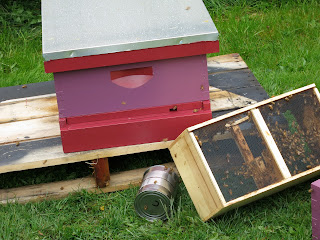One year ago, I started my first hive of honeybees, making for a fun and challenging and fascinating spring and summer of figuring out how to be a beekeeper. I winterized the hive and closed it up in October, but unfortunately the hive didn't make it.
It was very disheartening, but losing hives is sadly par for the course. So I decided to try again this year, going for round two and two hives. I got my packages from the Ballard Bee Company, who pick up over 250 packages in California and bring them back to Seattle on a custom trailer. By the time I got to his house to get my bees, there was just this pile remaining. Just this pile of about a million bees.
I got one package of Italian honeybees, which is what I had last year, and one German variety called Carniolan. These varieties are the most popular for backyard beekeepers as they are both gentle and well-suited to the Pacific Northwest climate. The bees come as 3 pounds, which is roughly 10,000 bees. There is also a canister of sugar water for them to eat and one mated queen inside a little queen cage.
A couple friends came over as moral support and assistants for the install process.
It's important to get the bees out of the travel package and into their new home as soon as possible so they don't get too stressed. I started with the Italians, taking the sugar water canister out and removing the metal wire with the queen cage.
Only, there was no cage attached to the wire! I stared in shock at the lone metal wire as I replaced the canister so bees would not escape. Somehow in the transport process, the cage had broken free, and now as I looked into the package, I knew the queen was down there, not visible, under the pile of thousands of bees.
I didn't know what to do. It was one of those moments where I wanted to slough this problem onto some one else. Let some one more experienced take over. I imagine that is often what it is like to be a parent- not knowing what the right answer is, but knowing that you are the only one who can deal with something so you better step up. I sent a friend inside the house to get tongs, and decided to just try to find the cage that way. It took a few tries, more bees escaping than usual, and a good bit of adrenaline, but I eventually got her cage out!
Here's the Italian queen, alive and well.
We taped the wire to the cage and then I very carefully removed the cork stopper and replaced it with a marshmallow before putting the queen in the hive.
Then I dumped the rest of the bees inside, put on the cover, and left the package sitting open by the entrance where the stragglers would eventually find their way to their new home. You can see that the travel box still has quite a few bees inside. When I came out the next day, EVERY bee was gone. That means the dead ones too. It's normal for a few bees to die in transit, so the living bees had removed their bodies. They are just crazy hygienic like that. So cool.
Four days later, I checked to make sure the bees had eaten the marshmallow and queen was out of her cage. I saw both queens, alive and well. Here you can see her, larger than the worker bees and marked with a red dot. The official dot color changes each year, so apparently 2013 is red. Now the goal is to see the queen start laying eggs!
Subscribe to:
Post Comments (Atom)









2 comments:
Yay! I'm so excited to follow you during year 2 as a beekeeper. Do you know where in CA he gets them? I bet you Carson knows the guy who sells them.
It was super cool watching you deal with the pressure of a dropped Queen! Thanks for inviting me over and I look forward to more updates. I had no idea that the living bees cleaned up the dead bees. Bees are so cool!
Post a Comment